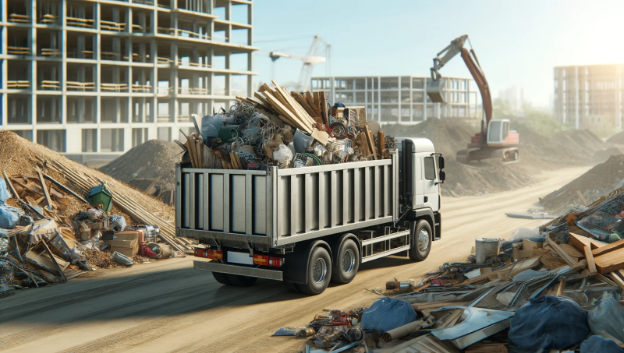
How to Handle Construction Debris Removal Efficiently
Construction projects, from small renovations to massive builds, inevitably create debris. Managing this waste efficiently isn’t just about cleanliness; it’s essential for safety, compliance, and environmental responsibility. In this guide, we’ll cover effective strategies for
construction debris removal, how to stay compliant with local regulations, and the benefits of waste recycling. By the end, you’ll have a roadmap for handling construction debris with ease and efficiency.
What is Construction Debris and Why is Proper Removal Important?
Construction debris includes various materials like wood, concrete, metal, bricks, drywall, and glass. Properly handling this waste isn’t just about clearing space—it reduces safety hazards and can even save on disposal costs.
Key Points:
- Safety Risks: Accumulated debris increases the risk of accidents, especially on active construction sites.
- Cost Savings: Managing waste correctly can reduce disposal costs and improve overall project efficiency.
- Environmental Impact: Recycling and repurposing debris can lower the environmental footprint of your project.
Steps for Effective Construction Debris Removal
1. Plan Waste Management Early
Start waste management planning at the beginning of your project. Outline what types of debris you’ll generate and determine disposal methods. This early planning can reduce costs and keep your project on track.
- Identify Waste Types: Knowing your debris type will help you select appropriate disposal or recycling methods.
- Estimate Volumes: Larger projects need dumpsters; smaller jobs may only require smaller containers.
2. Set Up a Debris Sorting Station
Setting up designated sorting areas for waste materials helps maximize recycling and reduces contamination of recyclable materials.
- Use Separate Containers: Designate containers for wood, metals, and other recyclables.
- Educate the Team: Ensure everyone understands the sorting process to maintain efficiency.
3. Choose the Right Dumpster Size
Dumpsters come in various sizes, typically from 10 to 40 cubic yards. Selecting the right size depends on the project scope.
| Dumpster Size | Ideal For |
|---|---|
| 10-15 cubic yards | Small remodels and light cleanups |
| 20-30 cubic yards | Medium projects like large room remodels |
| 40 cubic yards | Major construction and demolition projects |
4. Hire a Professional Junk Removal Service
Professional junk removal services bring expertise and equipment for efficient debris handling.
- Cost-Effective for Large Projects: They handle large loads that may be costly to dispose of independently.
- Safety Measures: Professionals are trained to manage hazardous materials and follow safety protocols.
5. Prioritize Recycling and Reuse
Much of the waste from construction sites can be recycled or reused. Many materials, like metals and wood, have value in secondary markets.
- Concrete and Asphalt: Can be crushed and used as new foundation material.
- Metals: Valuable for scrap; recycling metal is energy-efficient and reduces landfill waste.
- Wood and Drywall: Reclaimed wood can be used for other projects, while drywall can sometimes be recycled.
6. Dispose of Hazardous Waste Carefully
Hazardous construction waste, like asbestos, treated wood, and certain chemicals, requires special disposal.
- Follow Regulations: Hazardous materials need to be disposed of at certified facilities.
- Label Clearly: Clearly mark any hazardous materials to avoid contamination and ensure safe handling.
7. Regularly Schedule Debris Removal
For ongoing construction, regular debris removal keeps the site clean and prevents dangerous pile-ups.
- Weekly or Biweekly Pickups: Schedule pickups based on the project size and debris volume.
- Use a Project Timeline: Incorporate waste removal timelines into the project schedule to prevent delays.
Benefits of Construction Debris Recycling
Recycling construction waste isn’t just good for the environment—it also offers financial incentives and meets regulatory requirements.
| Material | Recycling Option | Benefit |
|---|---|---|
| Concrete/Asphalt | Crushed and reused as aggregate | Reduces landfill usage |
| Metals | Sold as scrap | Generates revenue |
| Wood | Reclaimed for other projects | Saves natural resources |
| Drywall | Recycled into new drywall or used as filler | Reduces production waste |
Key Advantages:
- Environmental Protection: Recycling reduces landfill waste and conserves resources.
- Compliance: Many regions have recycling mandates, especially for large projects.
- Cost Savings: Some materials, like metal, can be sold for profit, offsetting disposal costs.
Frequently Asked Questions (FAQs)
1. What types of construction debris can be recycled?
Materials like metals, concrete, asphalt, untreated wood, and cardboard are commonly recyclable. Ensure materials are clean and sorted to maximize recycling options.
2. Do I need a permit for construction debris removal?
Depending on your local regulations, you may need a permit, especially if you’re disposing of large amounts of waste or using public roads for dumpsters. Check with your local waste management authority for guidance.
3. What size dumpster should I rent for a small renovation?
For minor projects, a 10-15 cubic yard dumpster is typically sufficient. If you have more waste than expected, you can arrange for additional pickups or a larger dumpster.
4. Can I handle hazardous waste removal myself?
Only certified professionals should handle hazardous materials. Some materials require special permits and must be disposed of at licensed facilities.
5. How can I reduce the overall waste in my construction project?
Start by planning to use materials efficiently and choosing recyclable products when possible. Proper training on waste sorting and hiring a reliable removal service can also help reduce waste.
